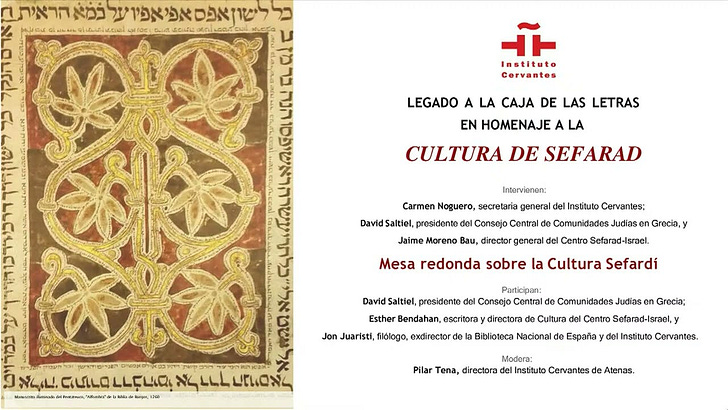Hola. This is Barbara, your guide to the latest cultural news from the Spanish-speaking world. This week, I’d like to briefly interrupt my series of specific book anniversaries to keep you posted with some interesting cultural snippets from the Sephardic world.
Honoring Sephardic culture and its legacy
The Caja de las Letras is a unique tradition of the Instituto Cervantes in Madrid. In it, prominent figures of Hispanic culture deposit personal legacies in a former bank vault repurposed as a cultural time capsule. These items, stored in safe deposit boxes, often include manuscripts, artefacts, or symbolic objects and are accompanied by a specified date for their future opening. This tradition celebrates the preservation of Spanish-language heritage and honours the contributors to its cultural legacy, such as writers, artists, and intellectuals.
Last September, it was not a single author to deposit some manuscripts in one of the boxes, but a whole cultural group. For a festive celebration, representatives of the Sephardic community came to Madrid to be honoured for the contributions of their language and culture to the Hispanic traditions. You can watch the video containing the speeches of David Saltiel, President of the Holocaust Museum of Greece and the Jewish Community of Thessaloniki, Carmen Noguero, General Secretary of the Cervantes Institute, and Jaime Moreno Bau, General Director of the Centro Sefarad-Israel.
In his presentation, David Saltiel underlines the importance of Thessaloniki, which played a pivotal role in the history of Sephardic culture, becoming a major centre of Jewish life and culture after the expulsion of Jews from Spain and Portugal in the late 15th century. Its role is unique because, by 1519, Jews represented 56 % of the city’s population, increasing to 68 % by 1613. The Jewish community maintained a significant presence and influence until the mid-20th century, providing an example of long-term Sephardic cultural continuity. Their secular language, Judeo-Spanish or Ladino, came to play a cohesive role as lingua franca among Jews of different linguistic and cultural backgrounds. As we all sadly know, this rich history came to a terrible halt with the Nazi occupation of Greece and the subsequent annihilation of its Jewish population. With the destruction of their hometown, most cultural artefacts got lost. After the war, the survivors, however, continued to transmit Ladino via daily conversation, songs, prayers, and proverbs to the new generations, which has been fundamental in keeping the cultural identity of the Jewish community alive. Saltiel’s speech is not only appealing because of his knowledge of Sephardic history but also because of his personal experience. The president of the Greek Holocaust Museum project has worked hard for more than twenty years to defend the rights and memory of the Greek Jewish community, excelling in the fight against racism and anti-Semitism.
After the speeches, a roundtable discussion with the following participants is shown: David Saltiel as representative of the Sephardic community of Greece, Esther Bendahan, author and Director of Culture at the Centro Sefarad-Israel, and philologist Jon Jaristi, former Director of the BNE and the Instituto Cervantes. Pilar Tena, Director of the Instituto Cervantes in Athens, facilitates the roundtable. Each participant highlights a different contribution of Sephardic culture to various literary genres, music, and expressions of identity. The discussion reveals the deep connection between Sephardic Jews and their cultural heritage. According to legend, they took the keys to their homes with them, hoping that future generations might one day return. Today, however, the Ladino language may be the most enduring key to Spain.
Here’s the video:
Contemporary Judaism in Colombia
As we all know, most Sephardic Jews and converts to Catholicism who fled to the Spanish «virreinatos» (vice-kingdoms) in the Americas never needed to preserve their own secular language of community in order to maintain their linguistic identity. Unlike in the Ottoman Empire, where Ladino evolved as a distinct variant, in Spanish-speaking countries, there was little need to maintain a separate Judeo-Spanish language. Later, in the 19th century, Jews from Curaçao, many of whom were of Sephardic origin, settled in cities like Barranquilla and Santa Marta, contributing to trade and commerce. Overall, Sephardic migration to South America was limited. Most Jewish migration to South America, especially in the 19th and 20th centuries, came from Ashkenazi communities.
Today, Colombia is a country with a tiny Jewish community (4’500-5’500 inhabitants). In recent years, there has been a notable trend in the country of individuals and communities converting to Judaism, often referred to as the Bnei Anusim (descendants of forcibly converted Jews) movement, as well as new converts drawn to Judaism for spiritual reasons. This phenomenon is part of a broader trend in Latin America.
The American photographer Laurence Salzmann has closely followed the adaptation processes of Jewish communities in Colombia. Salzmann documents their daily lives and spiritual practices. The photos of his visits with very different Jewish communities were shown during an exhibition at the Centro Colombo Americano in Medellín. All those of us who missed it can get some impressions from Salzmann’s video on contemporary Judaism in Colombia (2018) on YouTube.
«Patrigian mi Tiri»: Eggplant and Cheese casserole
If you have watched the video, you will probably have become a little hungry. Try this classical Jewish-Greek recipe of an eggplant and cheese casserole. It sounds and looks delicious, doesn’t it? By the way, if you don’t find matzo meal at your local grocery store, any ground breadcrumbs will do, too. Komed kon buen provecho.
This is all for today. Next time, I’ll resume the celebration of book anniversaries, with Almudena Grandes’s novel Los besos en el pan (The kisses on the bread). The novel was published 10 years ago.


